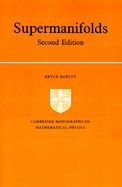3 - Super Lie groups. General theory
Published online by Cambridge University Press: 01 June 2011
Summary
Definition and structure of super Lie groups
Definition
We first recall the definition of a group. A group is a set G endowed with a binary-operation mapping F:G × G→G, abbreviated by F(x, y) = xy for all x, y in G and called multiplication, which has the following properties:
(1) (xy)z = x(yz) = xyz, for all x, y, z in G.
(2) There exists an element e of G, called the identity, such that ex = xe = x for all x in G.
(3) For every x in G there exists an element of G called the inverse of x, written x-1, such that x-1x = xx-1 = e.
It is easy to verify that e is a unique element of G and that every element has a unique inverse. In particular, e-1 = e and (x-1)-1 = x for all x in G.
A super Lie group is a group G that has also the following additional properties:
(4) It is a supermanifold, the points of which are the group elements.
(5) The multiplication mapping F is differentiate.
If, in the last two sentences, one replaces ‘supermanifold’ by ‘manifold’ and ‘differentiable’ by ‘C∞’ one has the definition of an ordinary Lie group.
Associated with every super Lie group G is an infinite family of ordinary Lie groups, each of which is obtained by replacing G with one of its skeletons (see section 2.1).
Information
- Type
- Chapter
- Information
- Supermanifolds , pp. 123 - 172Publisher: Cambridge University PressPrint publication year: 1992
